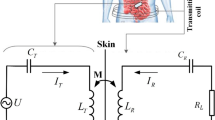Abstract
A wireless power transfer (WPT) system based on inductive resonant coupling makes it possible for endoscope micro robot (EMR) to explore intestine noninvasively. However, due to the increased demand for energy in such micro robot system, such as autonomous movement and drug delivery, the small receiving coil (Φ 15 mm × 13 mm) embedded in limited space on micro robot could not supply enough power as expected. To improve the power supply issue, this article proposes a three-coil WPT system for EMRs system. Based on the reflected impedance theory, the receiving end of three-coil WPT system is analyzed. Then, according to maximum power transfer principle, parameters relative to performance of WPT system have been optimized through simulation. After that, some bench tests are constructed. A good match is found between analysis results and experimental data. By comparing the three-coil PTW and two-coil WPT systems, it has verified that the transmission efficiency can be increased significantly to 11.2% by optimized three-coil WPT system and the power dissipation of receiving end could be reduced greatly when the micro robot is under a high power consumption, which is more suitable for endoscope micro robot system with limited space.











Similar content being viewed by others
References
Guo S, Yang Q, Bai L, Zhao Y (2018) Development of multiple capsule robots in pipe. Micromachines 9(6):259–274
Han D, Yan G, Wang Z et al (2020) The modelling, analysis, and experimental validation of a novel micro-robot for diagnosis of intestinal diseases. Micromachines 11(10):896
Mahoney AW, Abbott JJ (2016) Five-degree-of-freedom manipulation of an untethered magnetic device in fluid using a single permanent magnet with application in stomach capsule endoscopy. Int J Robot Res 35(1–3):129–147
Koulaouzidis A, Iakovidis DK, Karargyris A et al (2015) Wireless endoscopy in 2020: will it still be a capsule? World J Gastroenterol WJG 21(17):5119
Kuang S, Yan G (2020) Modelling on mutual inductance of wireless power transfer for capsule endoscopy. Biomed Microdevice 22(3):1–11
Ye C, Wang J, Fang Q (2019) A small wireless power transfer system for the capsule endoscopy. In: 2019 IEEE international conference on integrated circuits, technologies and applications (ICTA). IEEE, 166–167
Jones P, Spendier K, Routt A, et al. (2017) Magnetic field between a pair of solenoid: experiments vs. theory. Bull Am Phys Soc 62. http://meetings.aps.org/link/BAPS.2017.4CF.G1.29
Basar MR, Ahmad MY, Cho J et al (2016) Stable and high-efficiency wireless power transfer system for robotic capsule using a modified Helmholtz coil. IEEE Trans Ind Electron 64(2):1113–1122
Basar MR, Ahmad MY, Cho J, et al. (2015) Performance evaluation of power transmission coils for powering endoscopic wireless capsules. In: 2015 37th annual international conference of the IEEE engineering in medicine and biology society (EMBC). IEEE, 2263–2266
Basar MR, Ahmad MY, Cho J, Ibrahim F (2018) An improved wearable resonant wireless power transfer system for biomedical capsule endoscope. IEEE Trans Ind Electron 65(10):7772–7781
Ke Q, Luo W, Yan G, Yang K (2016) Analytical model and optimized design of power transmitting coil for inductive coupled endoscope robot. IEEE Trans Biomed Eng 63(4):694–706
Chyczewski S, Hwangbo S, Yoon YK et al (2019) Experimental demonstration of multi-watt wireless power transmission to ferrite-core receivers at 6.78 MHz. Wirel Power Transf 6(1):17–25
Pengxian PU, Guozheng YAN, Zhiwu W et al (2019) Design and experiment of expanding mechanism and power receiving coil for micro intestinal robot. J Shanghai Jiaotong Univ (Chin Ed) 53(10):1143
Meng Y, Wang Z, Jiang P et al (2020) Optimization and analysis of Helmholtz-like three-coil wireless power transfer system applied in gastrointestinal robots. J Power Electron 20(4):1088–1098
Wojda RP, Kazimierczuk MK (2013) Analytical optimization of solid-round-wire windings conducting dc and ac non-sinusoidal periodic currents. IET Power Electron 6(7):1462–1474
Hui SYR (2018) Technical and safety challenges in emerging trends of near-field wireless power transfer industrial guidelines[J]. IEEE Electromagnetic Compatibility Magazine 7(1):78–86
Ke Q, Jiang P, Yan G (2017) Standardized design of the transmitting coils in inductive coupled endoscope robot driving systems. J Power Electron 17(3):835–847
Yang Z, Liu W, Basham E (2007) Inductor modeling in wireless links for implantable electronics. IEEE Trans Magn 43(10):3851–3860
Acknowledgements
This research was funded by the National Natural Science Foundation of China (NSFC) (No. 62103263), Science and Technology Innovation Bases of Shanghai (19DZ2255200) and the Shanghai Pujiang Program (20PJ1419300).
Author information
Authors and Affiliations
Corresponding authors
Additional information
Publisher's Note
Springer Nature remains neutral with regard to jurisdictional claims in published maps and institutional affiliations.
Rights and permissions
About this article
Cite this article
Han, D., Yan, G., Kuang, S. et al. Preliminary Study on a Three-coil Wireless Power Transfer System for Endoscope Micro-robot of Intestinal Diagnosis: Design, Optimization and Validation. J. Electr. Eng. Technol. 17, 2213–2224 (2022). https://doi.org/10.1007/s42835-022-01022-5
Received:
Revised:
Accepted:
Published:
Issue Date:
DOI: https://doi.org/10.1007/s42835-022-01022-5




